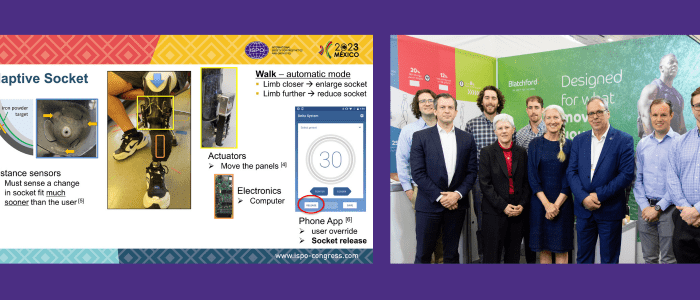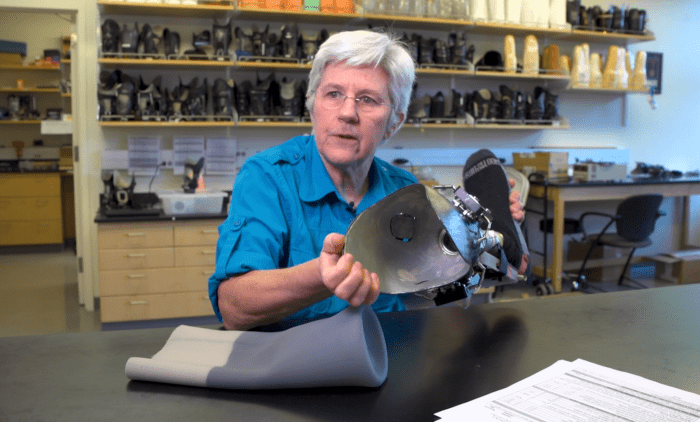Professor
jsanders@uw.edu
Phone: (206) 221-5872
Office: Foege N430J
Joan Sanders
Instrumentation
Innovative measurement techniques
Amputee
Rehabilitation
Bioimpedance
Biomechanics
A main area of on-going research is in residual limb fluid volume assessment. We developed a custom instrument to monitor residual limb fluid volume while an amputee subject wears their prosthesis. We use the instrument to assess how design variables of the prosthesis and subject affect fluid volume. For example, adding/removing prosthetic socks, applying elevated vacuum, and adjusting fluid within a bladder-liner have all been studied. This information is relevant to fit of the prosthesis since volume changes as small as 1.0% can affect clinical fit. A next step is to use the instrument towards the design of automated control strategies to adjust the prosthesis to accommodate limb volume fluctuations so as to maintain a proper fit.
Another area of focus is in the characterization of elastomeric materials used as a cushioning interface between the residual limb and prosthetic socket. We developed a testing suite of instrument to test commercially-available liner materials commonly used in the industry. Collected information is disseminated to the prosthetics community via an interactive website. Currently, we are developing training materials for enhancing use of the collected data for clinical care. We are also pursuing computational models to predict and compare interface mechanical action of different liners.
Applied research on skin adaptation to mechanical stress and skin breakdown is a third area of focus. This research has strong application in Rehabilitation Medicine where it is of interest to encourage adaptation so as to avoid skin breakdown or ulceration (wheelchair users, prosthesis users, bedridden patients). We developed an imaging system to quantify adaptation and to predict imminent skin breakdown. In pilot studies the instrument was shown to effectively predict imminent injury 1 to 2 months before it was visually apparent.
MS Mechanical Engineering – Northwestern University 1985
BS Mechanical Engineering – Stanford University 1983
Sanders JE, Cagle JC, Allyn KJ, Harrison DS, Ciol MA. How do the activities walking, standing, and resting influence trans-tibial amputee residual limb fluid volume? Journal of Rehabilitation Research and Development 2014; 51(2):201-212.
Sanders JE, Harrison DS, Allyn KJ, Myers TR, Ciol MA, Tsai EC. How do sock ply changes affect residual limb fluid volume in people with trans-tibial amputation? Journal of Rehabilitation Research and Development 2012; 49(2):241-256.
Sanders JE, Rogers EL, Sorenson EA, Lee GS, Abrahamson DC. CAD/CAM transtibial prosthetic sockets from central fabrication facilities: How accurate are they? Journal of Rehabilitation Research and Development 2007; 44(3):395-406.
D’Silva K, Hafner BJ, Allyn KJ, Sanders JE. Self-reported prosthetic sock use among persons with trans-tibial amputation. Prosthetics and Orthotics International 2014; 38(4):321-331.
Hafner BJ and Sanders JE. Considerations for development of sensing and monitoring tools to facilitate treatment and care of persons with lower limb loss. Journal of Rehabilitation Research and Development 2014;51(1):1-14.
In the News
Sanders lab awarded innovation prize for their development of a self-adjusting prosthetic leg
2023-05-03T10:17:57-07:00May 3rd, 2023|
Prof. Joan Sanders featured in UW Today
2022-10-21T13:02:05-07:00October 21st, 2022|
UW develops first successful auto-adjusting prosthetic socket
2022-08-05T15:19:21-07:00June 22nd, 2022|
Student’s smartphone apps connect remote populations to health care, help
2022-08-04T02:42:32-07:00March 18th, 2015|
Making good: Desire to help others inspires diverse research
2020-10-26T08:30:44-07:00December 15th, 2014|
Joan Sanders to present UW Medicine “Science in Medicine” Lecture, January 20, 2015
2021-01-21T06:04:34-08:00December 8th, 2014|










